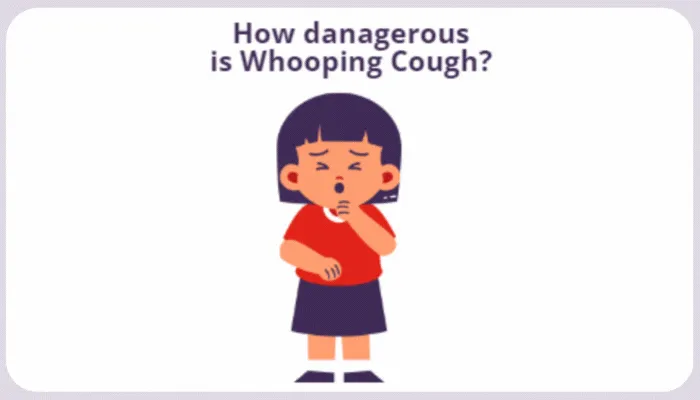Every child's well-being matters.
Best Practice Ideas for Safeguarding Articles
Quick Access

How Dangerous is Whooping Cough?
Highly contagious: Whooping cough, caused by the bacterium Bordetella pertussis, spreads easily through respiratory droplets.
Severe symptoms: Characterised by intense, prolonged coughing fits that may last weeks or months, it can cause significant distress and complications.
Life-threatening risks for vulnerable groups: While severity varies, whooping cough can be fatal, especially in young infants and those with weakened immune systems.
Complications: In severe cases, it can lead to pneumonia, seizures, brain damage, and sometimes death in infants.
Demographics Most at Risk
1. Infants (especially under six months):
Extreme risk: Babies too young to be fully vaccinated are at the highest risk.
Severe complications: This includes pneumonia, seizures, apnoea (temporary breathing cessation), and in extreme cases, death.
Hospitalisation rates: Approximately half of infants under one year old with pertussis require hospitalisation.
2. Older children and adults:
Less severe but persistent symptoms: While symptoms may resemble a prolonged cold, complications can still occur, such as rib fractures, hernias, and pneumonia.
Transmission risk: Mild or undiagnosed cases in adults can easily spread the disease to infants.
3. Pregnant women:
Potential impact on newborns: Babies are particularly vulnerable to severe outcomes if infected soon after birth.
Prevention through vaccination: The Tdap vaccine during pregnancy offers passive immunity to the newborn, critical in the first few months of life.
4. Immunocompromised individuals:
High risk of severe complications: This includes pneumonia, which can further strain fragile health.
Your Responsibilities in Early Years for Safeguarding Against Whooping Cough
Promote vaccination compliance: Encourage parents to follow vaccination schedules for DTaP and Tdap to reduce infection risks.
Educate staff and parents: Provide information on recognising symptoms and understanding the importance of vaccinations.
Implement illness policies: Require unwell children and staff to stay home until they are no longer contagious to prevent outbreaks.
Respond swiftly to symptoms: Encourage early medical evaluation for any child or staff member showing signs of whooping cough, particularly to prevent spread among high-risk infants.
Protect vulnerable infants: Pay special attention to infants under six months, implementing preventive measures to minimise their exposure.
AUTHOR:- Iona has nearly 10 years of experience supporting nurseries and childminders in curriculum planning, leadership, and safeguarding. Her writing is informed by public information and sector insight, aiming to provide accessible, practical support for professionals working with children. She is part of the On the Button team, helping deliver Well-being, Safeguarding and Complaint Management Software that empowers practitioners to identify concerns early and act confidently.
On the Button provides innovative software tailored to the needs of the early years sector, with a strong focus on EYFS well-being and early years safeguarding. Our tools help senior practitioners to confidently track concerns, maintain robust records, and respond effectively — all while meeting statutory guidance. From early years complaint management to team-wide safeguarding alerts, our platform puts children's safety and emotional health first.
Quick Access

How Dangerous is Whooping Cough?
Highly contagious: Whooping cough, caused by the bacterium Bordetella pertussis, spreads easily through respiratory droplets.
Severe symptoms: Characterised by intense, prolonged coughing fits that may last weeks or months, it can cause significant distress and complications.
Life-threatening risks for vulnerable groups: While severity varies, whooping cough can be fatal, especially in young infants and those with weakened immune systems.
Complications: In severe cases, it can lead to pneumonia, seizures, brain damage, and sometimes death in infants.
Demographics Most at Risk
1. Infants (especially under six months):
Extreme risk: Babies too young to be fully vaccinated are at the highest risk.
Severe complications: This includes pneumonia, seizures, apnoea (temporary breathing cessation), and in extreme cases, death.
Hospitalisation rates: Approximately half of infants under one year old with pertussis require hospitalisation.
2. Older children and adults:
Less severe but persistent symptoms: While symptoms may resemble a prolonged cold, complications can still occur, such as rib fractures, hernias, and pneumonia.
Transmission risk: Mild or undiagnosed cases in adults can easily spread the disease to infants.
3. Pregnant women:
Potential impact on newborns: Babies are particularly vulnerable to severe outcomes if infected soon after birth.
Prevention through vaccination: The Tdap vaccine during pregnancy offers passive immunity to the newborn, critical in the first few months of life.
4. Immunocompromised individuals:
High risk of severe complications: This includes pneumonia, which can further strain fragile health.
Your Responsibilities in Early Years for Safeguarding Against Whooping Cough
Promote vaccination compliance: Encourage parents to follow vaccination schedules for DTaP and Tdap to reduce infection risks.
Educate staff and parents: Provide information on recognising symptoms and understanding the importance of vaccinations.
Implement illness policies: Require unwell children and staff to stay home until they are no longer contagious to prevent outbreaks.
Respond swiftly to symptoms: Encourage early medical evaluation for any child or staff member showing signs of whooping cough, particularly to prevent spread among high-risk infants.
Protect vulnerable infants: Pay special attention to infants under six months, implementing preventive measures to minimise their exposure.
AUTHOR:- Iona has nearly 10 years of experience supporting nurseries and childminders in curriculum planning, leadership, and safeguarding. Her writing is informed by public information and sector insight, aiming to provide accessible, practical support for professionals working with children. She is part of the On the Button team, helping deliver Well-being, Safeguarding and Complaint Management Software that empowers practitioners to identify concerns early and act confidently.
On the Button provides innovative software tailored to the needs of the early years sector, with a strong focus on EYFS well-being and early years safeguarding. Our tools help senior practitioners to confidently track concerns, maintain robust records, and respond effectively — all while meeting statutory guidance. From early years complaint management to team-wide safeguarding alerts, our platform puts children's safety and emotional health first.

How Dangerous is Whooping Cough?
Highly contagious: Whooping cough, caused by the bacterium Bordetella pertussis, spreads easily through respiratory droplets.
Severe symptoms: Characterised by intense, prolonged coughing fits that may last weeks or months, it can cause significant distress and complications.
Life-threatening risks for vulnerable groups: While severity varies, whooping cough can be fatal, especially in young infants and those with weakened immune systems.
Complications: In severe cases, it can lead to pneumonia, seizures, brain damage, and sometimes death in infants.
Demographics Most at Risk
1. Infants (especially under six months):
Extreme risk: Babies too young to be fully vaccinated are at the highest risk.
Severe complications: This includes pneumonia, seizures, apnoea (temporary breathing cessation), and in extreme cases, death.
Hospitalisation rates: Approximately half of infants under one year old with pertussis require hospitalisation.
2. Older children and adults:
Less severe but persistent symptoms: While symptoms may resemble a prolonged cold, complications can still occur, such as rib fractures, hernias, and pneumonia.
Transmission risk: Mild or undiagnosed cases in adults can easily spread the disease to infants.
3. Pregnant women:
Potential impact on newborns: Babies are particularly vulnerable to severe outcomes if infected soon after birth.
Prevention through vaccination: The Tdap vaccine during pregnancy offers passive immunity to the newborn, critical in the first few months of life.
4. Immunocompromised individuals:
High risk of severe complications: This includes pneumonia, which can further strain fragile health.
Your Responsibilities in Early Years for Safeguarding Against Whooping Cough
Promote vaccination compliance: Encourage parents to follow vaccination schedules for DTaP and Tdap to reduce infection risks.
Educate staff and parents: Provide information on recognising symptoms and understanding the importance of vaccinations.
Implement illness policies: Require unwell children and staff to stay home until they are no longer contagious to prevent outbreaks.
Respond swiftly to symptoms: Encourage early medical evaluation for any child or staff member showing signs of whooping cough, particularly to prevent spread among high-risk infants.
Protect vulnerable infants: Pay special attention to infants under six months, implementing preventive measures to minimise their exposure.
AUTHOR:- Iona has nearly 10 years of experience supporting nurseries and childminders in curriculum planning, leadership, and safeguarding. Her writing is informed by public information and sector insight, aiming to provide accessible, practical support for professionals working with children. She is part of the On the Button team, helping deliver Well-being, Safeguarding and Complaint Management Software that empowers practitioners to identify concerns early and act confidently.
On the Button provides innovative software tailored to the needs of the early years sector, with a strong focus on EYFS well-being and early years safeguarding. Our tools help senior practitioners to confidently track concerns, maintain robust records, and respond effectively — all while meeting statutory guidance. From early years complaint management to team-wide safeguarding alerts, our platform puts children's safety and emotional health first.




Facebook
Instagram
LinkedIn
Youtube